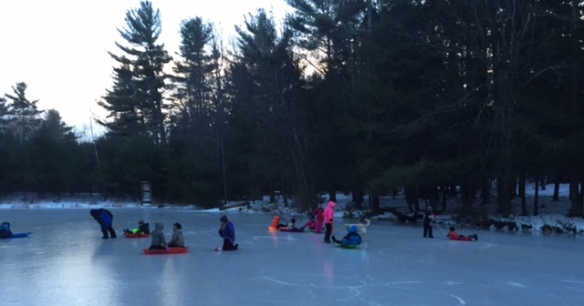
It didn’t look like we’d get smooth ice this year. A couple of weeks of sub-freezing weather formed a nice black ice, but just when I tested it and deemed it safe we had a couple of inches of snow, just heavy enough to push the ice down far enough for water to seep up through the expansion cracks in the ice. As soon as that water reaches the snow the snow sucks the water up like a sponge, and the ice becomes covered by slush. Even though the ice beneath is still safe I don’t allow the kids out on the slush, because it is too wet, and also the footprints they leave in the slush are fossilized by the next night’s freeze, and then you have very rough ice due to footprints.
When the slush freezes it makes the ice thicker and safer, but the surface is rough, like crusty snow. Also, after a blast of bitter cold, down to -4°F (-20°C), mild air began pushing back from the south. We promptly got four inches of snow, and the entire process began to repeat itself, with the snow again turning to slush atop the ice. But the south wind became a surge, and we had some real yo-yo weather, with temperatures shooting up to 50°F (+10°C) and pouring rain, before temperatures plunged back down to 7°F (-14°C). The rain flooded the surface of the pond, and, when it flash-froze, the ice was glassy smooth.
The ice was so smooth that, by holding the rope of a plastic sled and swinging the child around, I could enact a sort of Olympic hammer-throw and send the child spinning and shrieking down the entire length of the pond. Of course, once I did it to one child, I had to do it for all the others. Otherwise I’d face a chorus of, “It’s not fair!” Over and over I was a sort of amusement park ride, whipping kids around and around and then sending the sled spinning down the pond. Man, are my arms ever sore! Finally I had to teach them how to fling each other, because I was getting worn out.
It was surprising how swiftly they caught onto the art of something that, as a boy, we called “cracking-the-whip”, wherein a chain of sliding children pivots, with the child at the axis basically standing still, but the child out at the end of the chain going so atrociously fast that they can’t hold on, and are flung away laughing and sliding over the ice.
There is nothing quite like the din made by children playing on the ice. Once I educated them in the art of flinging, I didn’t have to work any more, and I could simply stand back and listen. It seemed to joyously echo back through time to the time of the Dutch Masters, painting in the Little Ice Age.

It is amazing how many paintings were painted involving skating on the frozen canals, back then. They may not have had thermometers, but simply by dating their paintings one has ample evidence it was, winter after winter, far colder. Painting was a way to make winter wonderful, and became part of their wonderful lore about wonderful winters.
The tale of “Hans Brinker and The Silver Skates” was based on that lore, although the author Mary Mapes Dodge had never visited Holland. She had Dutch immigrant neighbors who told her much about life and childhoods in the Netherlands, and she also was a student of Dutch history, and published the best-seller in 1865, towards the end of the Little Ice Age. (Within the tale is another famous tale, of the little boy who saves Haarlem by stopping a leak in a Dike with his finger.) (Children were amazingly responsible in her tales.) Besides being popular in the USA, her writing was popular in the Netherlands, and they embraced the tale and adopted it as their own, for it caught the feeling of their love of skating and frozen canals.

As the Little Ice Age faded away the canals froze less often, (and pollution added warmth to the water as well), and skating became all the more special as it became more rare. Of course, with the advent of the Global Warming hysteria, some seized upon the lack of skating as proof mankind was guilty of polluting the planet to such a degree that we all were going to boil. This was reaching a peak in late 2008, (the leaked Climategate emails didn’t expose the fact the public was being badly bamboozled until November 2009). There was even a famous prognosis that “Children will not know what snow is like”, but then at the end of 2008 winter threw a wrench in the works of such hysteria, with bitter cold blasts, and the Dutch got to skate like they had in the past. It made it a bit harder to talk of “Global Warming”, when the pictures were so similar to the 1600’s.
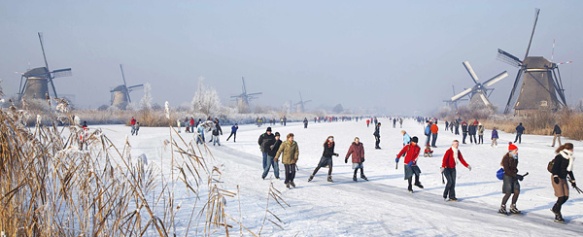
It became a national craze, complete with traffic jams, and orders for trains to travel slower, as people crossed tracks moving from one canal to the next.

Of course, as the crowds grow, people get carried away, and sooner or later they start driving vehicles on the ice. Even the Dutch Masters saw this happening, back in the 1600’s.
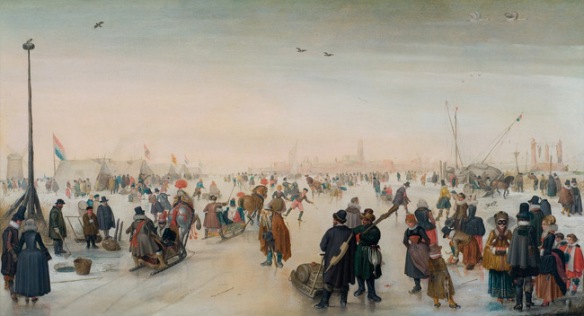
I figured I’d nip any such ideas in the bud, and instituted a rule at my Childcare that there should be no trucks driven on the ice. But would the children listen?
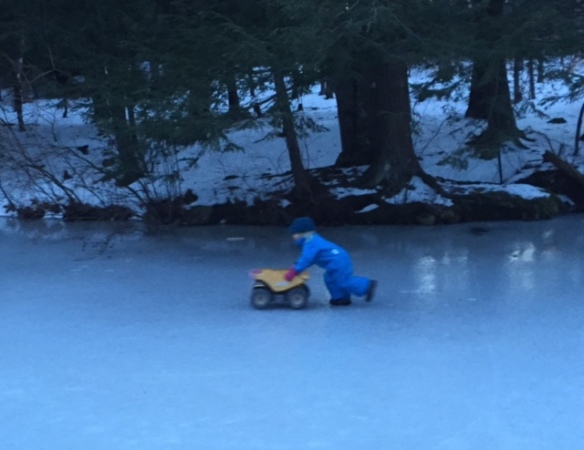
It was obvious to me that this young lady needed a driver, but I was too stiff and sore. It reminded me of the Beatle’s song from their “Rubber Soul” album, “Drive my car”, and I began to hum it to my self. I love the song’s concluding couplet:
I’ve got no car, and it’s breaking my heart,
But I’ve got a driver, and that’s a start!
And as I hummed that part of the song the young lady came by again, and indeed she had found herself a driver.
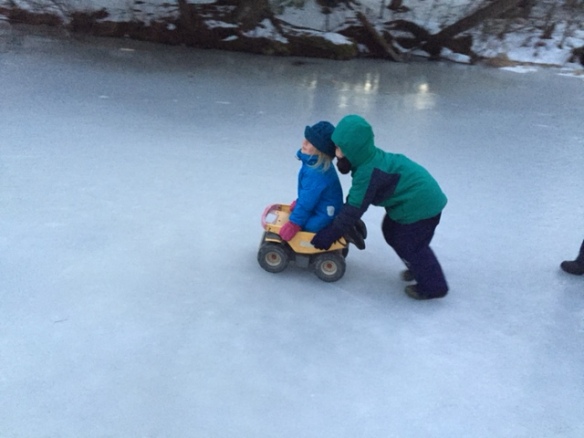
As I looked around all I could think was the sound in the air was the sound of joy.
Ice this perfect never lasts. But I am not going to be one of those people who always has to spoil things by foreseeing a bad future. If Global Warming happens, we’ll just find warmer things to be joyous about.
What is it about smooth ice different
From polished marble? The slide is farther.
The joy is greater. The air, heaven sent,
(So different from a funeral parlor),
Sparkles and freezes hair in my old nose
As the children romp, dance, and go mad
With glee at scent so far from summer’s rose
That comparing’s absurd, yet just as glad
Is the human heart on winter’s ice.
Go polish your marble. Your mausoleum
Will never match my pond, though it may suffice
For those whom find more life in a museum
Than in noise from a pond where children mingle,
Glittering sound much like sleigh-bell’s jingle.
